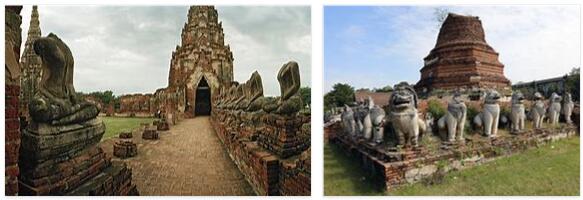
Ayutthaya was the capital of the empire of the same name from 1350 to 1767. In its heyday, the city had three royal palaces, 375 temples and an impressive city wall. Magnificent temples and palaces still bear witness to their former size. The main attraction is the temple Wat Sri Sanpeth with three monumental stupas.
Ayutthaya Ruins: Facts
| Official title: | Ayutthaya ruins |
| Cultural monument: | the royal residence city of 33 kings, located on the Chao Phraya, with monastery and temple complexes such as Wat Si Sanphet, built as a private temple of the royal family and the largest temple complex in Ayutthaya, Wat Ratchaburana, Chedi Phu Khao Thong, Wat Phra Ram, Wat Na Phra Men and Wat Mahathat with a once 46 m high prang |
| Continent: | Asia |
| Country: | Thailand |
| Location: | Ayutthaya, north of Bangkok |
| Appointment: | 1991 |
| Meaning: | the former Siamese royal city as a jewel of Buddhist architecture and shaped by the Ayutthaya style with its strict symmetry for epochs |
Ayutthaya Ruins: History
| 1350-1767 | Kingdom of Ayutthaya with five dynasties |
| 1350 | under Rama (King) Thibodi foundation as capital and residence city |
| 1350-1488 | Ayutthaya art’s heyday |
| 1492-1532 | Construction of the chedis (repository of relics) at Wat Si Sanphet |
| 1511 | Portuguese discover Siam |
| 1569 | Construction of the 80 m high Chedi Phu Kao Thong |
| 1590-1605 | King Naresuan |
| 1656-88 | King Narai |
| 1767 | Destruction by the Burmese |
| 1956 | first restoration measures |
| 1958 | Rediscovery of the art treasures of Wat Ratchaburana |
| 1971 | Restoration of Wat Putthai Sawan |
Where kings ruled as gods
“Another temple and another,” complained the English writer Somerset Maugham when he was persuaded to visit the former center of power in Siam during a stop at Ayutthaya train station in the 1920s.
There were once three royal palaces, 375 temples, 29 forts and 94 city gates on the three by five kilometer river island that formed the core of the most influential city in Southeast Asia in the 14th to 16th centuries. In view of the abundance of architectural monuments that are still preserved today, one can understand Maugham, who mostly preferred to be content with the view from the train window in order to get an idea of an unfamiliar environment.
With the fabulous population of one million, which historians keep mentioning, but even with fewer residents, the most important city of Siam left all the European metropolises of its time behind. The pomp and pomp that the kings residing here displayed until the complete destruction of their powerful capital in the second half of the 18th century will quickly make you forget that of the old world. British, Chinese, French, Dutch, Japanese and Portuguese living in their own districts outside the walls vied for the favor of kings, the first of whom, the ruler of the principality of U Thong, saw himself as the reincarnation of the god Vishnu. His residence city was to be like the legendary island state of Ayodhya in the Indian epic “Ramayana”, whose hero he felt himself to be. While Ayutthaya’s predecessor Sukhothai fell more and more into oblivion, the rulers of the new empire consolidated their status. Their soldiers shook off the Khmer yoke and even conquered the legendary Angkor. From there they took over the god-kingship, the content of which has now been transferred to the king as Bodhisattva, as a Buddha-like. The figure of the faithful caring father, who cared about the well-being of his subjects – today she embodies King Bhumibol again – had had its day for a long time. Temple after temple was built as a manifestation of one’s own greatness, with the feeling and awareness of being heirs to both Sukhothai and Angkor. The Chedi, a bell-like tower tapering to the top for storing relics – in Sukhothai from the Indian stupa, a sacred and burial building.
In Ayutthaya, a style was born that adapted to the Thai people’s sense of art by changing proportions and contours. Buddhist simplicity combined with Thai sensual pleasure. Monumental force gave way to playful grace. This new style of the God-King at the zenith of absolute power has been decisive for the art of Siam until today.
The orgy of violence by the Burmese warriors reduced the glory of Ayutthaya to rubble and ashes; But even in dilapidated stone and stucco facades, the mighty old residence doesn’t just seem to be alive at night when the light from the spotlights lifts it out of the darkness. Believers light incense sticks in the rubble and decorate sacred trees with colorful ribbons. They turn to Buddha, whose likenesses have been deprived of their value a thousand times over by chopping off their heads.
According to politicsezine, Ayutthaya is more than just an epoch turned stone for the Thais, who get to know the history of the former Siamese royal city in school from the third grade and most of whom have the wish to travel there at least once in their life. It is the symbol of a national pride that – unlike Somerset Maugham and the multitude of camera-hung package tourists who appear rushed by a busy schedule – one has to patiently embrace in order to see more than just a huge collection of temple and palace ruins.